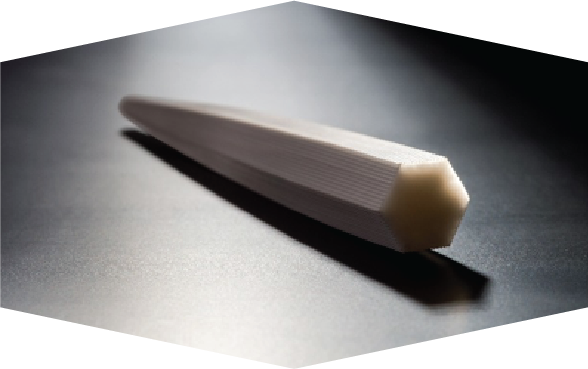- Analyzers
- Optics & Sources
- Technologies
- Support
- About
The Evolution of Polycapillary Optics
INTRODUCTION
The concept of polycapillary optics was introduced in the late 1980’s. During this time, XOS and a few other groups around the world conducted extensive research and development to significantly improve the optic manufacturing process. As a result, XOS became a leading global manufacturer of highperformance X-ray polycapillary optics and excitation systems. Today, polycapillary X-ray optics are used as key components in high-end X-ray analytical instruments and have dramatically enhanced system performance.
BACKGROUND
A polycapillary X-ray optic consists of an array of tiny glass capillaries (up to a few million) formed into a well-defined shape. It collects a large solid angle of X-rays from a divergent X-ray source and redirects them by multiple external total reflections, to form either a focused beam (Figure 1) or a quasi-parallel beam (Figure 2).
Figure 1: Focusing X-ray Optic
A polycapillary focusing optic can focus the X-rays to a spot size as small as 5µm (at Rh Ka radiation, 20.2 keV). The X-ray flux density obtained at the focus of the optic can be up to five orders of magnitude higher than that obtained with a conventional pinhole collimator. This level of X-ray flux density improvement has been a game-changer for micro X-ray fluorescence.


The most important aspects of a polycapillary optic are the design and performance parameters:
- Input focal distance (IFD): To define where the X-ray source is to be placed
- Output focal distance (OFD): To define where the smallest beam size is obtained
- Focal spot size: Energy dependent and normally characterized using the knife-edge method
- Effective collection solid angle (ECSA): Directly proportional to the output beam intensity
- Intensity gain: Comparison to a conventional pinhole collimator
- Transmission efficiency: Ratio of the X-rays exiting the output end of the optic to those entering the optic at the input end
Figure 2: Collimating X-ray Optic
A polycapillary collimating optic, with the output beam diameter as large as 25mm, can generate a quasi-parallel X-ray beam for applications such as X-ray diffraction (XRD) and wavelength dispersive spectrometry (WDS). Depending on the X-ray energy, the collection solid angle of the optic can be up to 40˚ and the transmission efficiency can reach 40%.


CONCLUSION
The advances of the polycapillary X-ray optics have made it a must-have optical component in high-end X-ray analytical instruments for pioneering industrial applications like micro XRF. The optics have also been successfully used in synchrotron radiation facilities for research in micro X-ray analysis (XRF and X-ray absorption spectroscopy). Other unique applications include confocal XRF analysis and super-conducting EDS detectors.

